
Artificial Life VII, August 2000
Creating a Physically-Based, Virtual-Metabolism with Solid Cellular Automata (SOCA)
Alan Dorin
http://www.cs.monash.edu.au/~aland
aland@cs.monash.edu.au
Centre for Electronic
Media Art
School of Computer Science & Software Engineering
Monash University, Melbourne, Australia
|
|
To model an organism...
network of self-sustaining, self-bounding, auto/cross-catalytic chemical processes.
...in the spirit of Monod, Kauffman, Prigogine, Maturana & Varela.Organism components act entirely within the limits imposed by...
The Physical Model
Model of rigid, convex, polyhedra which are:
The Cellular Automaton Model
Previous Work: Chaining SOCA elements

|
Forces |
Grey |
Blue |
Green |
|
Grey |
-0.25 |
0 |
0 |
|
Blue |
0 |
-1 |
+1 |
|
Green |
0 |
+1 |
-1 |
Previous Work: Size-limited and fracturing clusters of SOCA elements
|
Forces |
Grey |
Blue |
Green |
Red |
|
Grey |
-1
|
-1
|
-1
|
0
|
|
Blue |
-1
|
-60
|
-30
|
-20
|
|
Green |
-1
|
-30
|
+70
|
-2
|
|
Red |
0
|
-20
|
-2
|
+70
|
|
Transitions |
Grey |
Blue |
Green |
Red |
|
Grey |
-
|
-
|
-
|
-
|
|
Blue |
-
|
-
|
-
|
-
|
|
Green |
-
|
-
|
8,Red,0
|
1,Red,0
|
|
Red |
-
|
-
|
-
|
10,Green,0
|
|
|
|
|
|
|
|
Red |
+ Blue |
Magenta |
+ Cyan |
|
Forces: |
Null (rely on kinetic energy of elements & random collisions) |
|
Transitions |
Grey |
Red |
Blue |
Cyan |
Magenta |
|
Grey |
-
|
-
|
-
|
-
|
-
|
|
Red |
-
|
-
|
1,Magenta,0
|
-
|
-
|
|
Blue |
-
|
1,Cyan,0
|
-
|
-
|
-
|
|
Cyan |
-
|
-
|
-
|
-
|
-
|
|
Magenta |
-
|
-
|
-
|
-
|
-
|
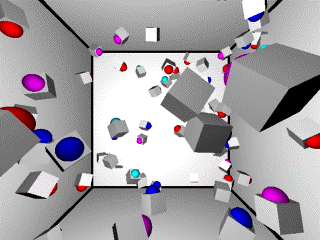 |
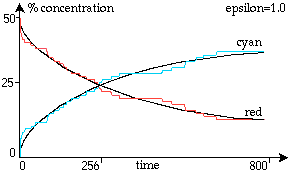 |
|
Illustration of (contained) reaction |
Concentration vs. Time (plot) |
|
|
|
 |
|
|
|
|
||||
|
Red |
+ Blue |
Green/Yellow catalyst |
Magenta |
+ Cyan |
|
Transitions: |
Blue -> Cyan |
(in the presence of Red) |
|
Forces |
Grey |
Green |
Blue |
Red |
Cyan |
Magenta |
Yellow |
|
Grey |
0
|
0
|
0
|
0
|
0
|
0
|
0
|
|
Green |
0
|
0
|
0
|
+500
|
0
|
-500
|
0
|
|
Blue |
0
|
0
|
0
|
0
|
0
|
0
|
+500
|
|
Red |
0
|
+500
|
0
|
0
|
0
|
0
|
0
|
|
Cyan |
0
|
0
|
0
|
0
|
0
|
0
|
-500
|
|
Magenta |
0
|
-500
|
0
|
0
|
0
|
0
|
0
|
| Yellow |
0
|
0
|
+500
|
0
|
-500
|
0
|
0
|
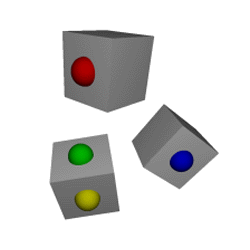 |
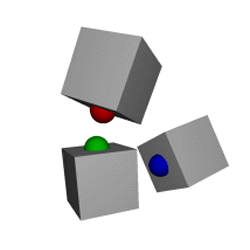 |
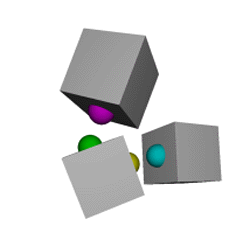 |
|
t=0 Red, Blue and a Green/Yellow catalyst |
t=100 Red has been pulled towards Green |
t=120 Red and Blue have been pulled into proximity and react to form Magenta and Cyan which then frees the catalyst |
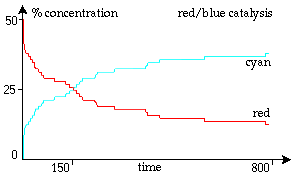 |
|
Concentration vs. Time (plot) |
 |
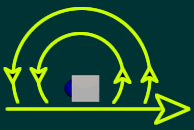 |
 |
|
Green |
Blue catalyst |
Blue |
|
Forces: |
Green >attract< Blue Blue <repel> Blue |
|
|
Transitions: |
Green -> Blue |
(in the presence of Blue) |
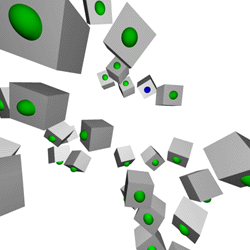 |
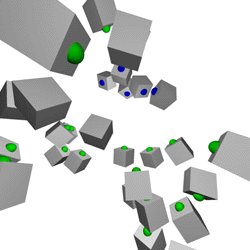 |
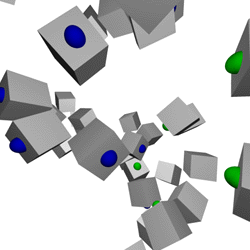 |
|
t=0 Lots of Green, one Blue (at the back) |
t=300 Green turns towards expanding collection of Blue |
t=900... Blue collection continues to expand converting more and more Green to Blue |
|
Red |
+ Blue |
Green catalyst |
Inert |
+ Yellow |
|
|
|
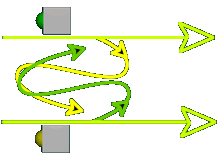 |
|
|
 |
 |
 |
 |
|
|
Magenta |
+ Cyan |
Yellow catalyst |
Inert |
+ Green |
The reactions produce catalyst for each other
|
Forces: |
Blue >attract< Green Red >attract< Green |
|
|
Magenta >attract< Yellow Cyan >attract< Yellow |
||
|
Transitions: |
Red -> Inert Blue -> Yellow |
(in the presence of Blue) (in the presence of Red) |
|
Magenta -> Inert Cyan -> Green |
(in the presence of Cyan) (in the presence of Magenta) |
|
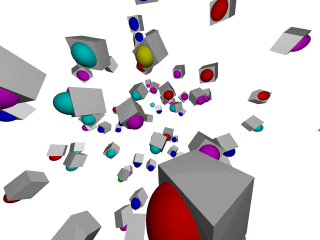 |
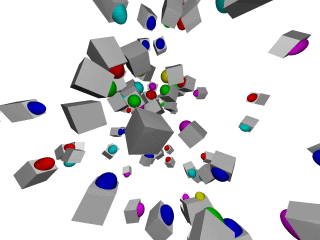 |
|
t=0 Lots of Blue/Red, Cyan/Magenta, a bit of Yellow & Green |
t=900... Blue/Red, Cyan/Magenta pulled towards their respective catalysts to manufacture more catalyst |
Q: Which SOCA topology might potentially be formed from a set of cross-catalytic reactions?
A: The cluster / star is:
Q: How can a cluster / star be produced using virtual cross-catalytic reactions?
A: Yellow & Green catalyst elements produced by cross catalytic reactions (above) may be clustered together to produce a topology which is:
|
Red |
+ Blue/Grey |
Green/Grey catalyst |
Inert |
+ Yellow/Grey |
|
|
|
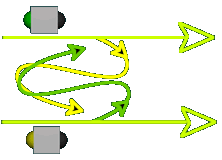 |
|
|
 |
 |
 |
 |
|
|
Magenta |
+ Cyan/Grey |
Yellow/Grey catalyst |
Inert |
+ Green/Grey |
|
Forces: |
Blue >attract< Green Red >attract< Green |
|
|
Magenta >attract< Yellow Cyan >attract< Yellow |
||
|
Grey >attract< Grey |
||
|
Transitions: |
Red -> Inert Blue -> Yellow |
(in the presence of Blue) (in the presence of Red) |
|
Magenta -> Inert Cyan -> Green |
(in the presence of Cyan) (in the presence of Magenta) |
|
|
Grey -> Inert |
(in the presence of 3 Grey) |
|
* Optional forces & transitions for reproduction by fracture
These structures may even fracture (using process explained for fracturing, size-limited structures above) and therefore reproduce whilst maintaining the cross-catalytic reactions.
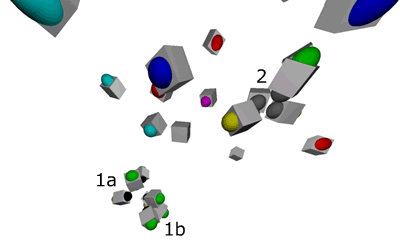
Dynamic, fracturing clusters formed by (virtual) cross-catalysis
The following SOCA models have been presented:
In the future some motile structures which have been constructed using SOCA will be demonstrated.
©Copyright Alan Dorin/Animaland 2000